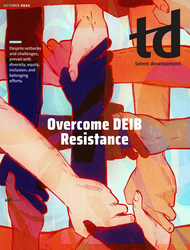TD Magazine Article
Everybody Wins With Inclusive Training
Make accessibility modifications to enhance programs.
Tue Oct 01 2024
Are you doing everything you can to reach all your learners? That is, are you using all the implements in your toolbox to reach non-native speakers, neurodivergent employees, as well as those who may have a disability?
In "Enhance Accessibility in Virtual Training Environments," Gwen Navarrete Klapperich guides L&D professionals on how to structure their learning assets and conduct training to give them and their learners the greatest chance of a successful learning program.
Among her tips for the training environment:
Use large text, symbols, and images. The latter will help not only learners who have low vision but also non-native speakers.
Check to ensure proper lighting and acoustics to aid individuals with low vision and those who are hard of hearing or deaf.
Stick with simple instructions, which benefits learners who are neurodivergent, have low literacy levels, or who are non-native speakers.
Provide transcripts and record the training. All learners may want to review content.
Supply real-world examples, which can aid non-native speakers and learners with low literacy.
Design electronic work so that learners can complete it with a keyboard and limited scrolling.
Regularly incorporating assistive technologies greatly enhances inclusive learning. However, for the most effective learning, ask learners in advance what accommodations—such as a sign language interpreter—they may need.
These tips were adapted from the October 2024 issue of TD at Work. Learn more at td.org/TDatWork.

